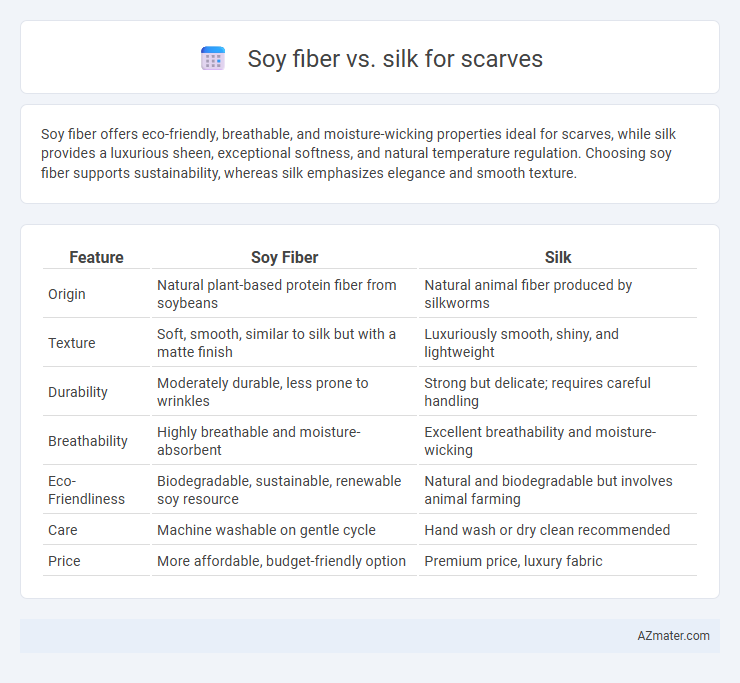Soy fiber offers eco-friendly, breathable, and moisture-wicking properties ideal for scarves, while silk provides a luxurious sheen, exceptional softness, and natural temperature regulation. Choosing soy fiber supports sustainability, whereas silk emphasizes elegance and smooth texture.
Table of Comparison
| Feature | Soy Fiber | Silk |
|---|---|---|
| Origin | Natural plant-based protein fiber from soybeans | Natural animal fiber produced by silkworms |
| Texture | Soft, smooth, similar to silk but with a matte finish | Luxuriously smooth, shiny, and lightweight |
| Durability | Moderately durable, less prone to wrinkles | Strong but delicate; requires careful handling |
| Breathability | Highly breathable and moisture-absorbent | Excellent breathability and moisture-wicking |
| Eco-Friendliness | Biodegradable, sustainable, renewable soy resource | Natural and biodegradable but involves animal farming |
| Care | Machine washable on gentle cycle | Hand wash or dry clean recommended |
| Price | More affordable, budget-friendly option | Premium price, luxury fabric |
Introduction: Soy Fiber vs Silk in Scarves
Soy fiber scarves offer a sustainable and eco-friendly alternative to traditional silk, boasting a soft texture and natural sheen that mimics silk's luxurious feel. Unlike silk, which is derived from silkworm cocoons and often involves intensive farming practices, soy fiber is produced from soy protein, making it biodegradable and gentle on the skin. Both materials provide excellent breathability and drape, but soy fiber scarves tend to be more affordable and hypoallergenic, appealing to eco-conscious consumers.
Origins and Production Methods
Soy fiber is derived from the byproducts of soybean processing, where the protein extracted from soybean hulls is spun into a soft, biodegradable fabric using a wet-spinning method. Silk originates from silkworm cocoons, particularly the Bombyx mori species, produced through an intricate reeling process that preserves the long protein fibers for a luxurious, natural textile. Both fibers reflect sustainable practices, with soy fiber emphasizing plant-based innovation and silk relying on traditional sericulture techniques.
Environmental Impact and Sustainability
Soy fiber, derived from soybean protein, offers a biodegradable and renewable alternative to silk, reducing reliance on animal products and lowering carbon emissions during production. Silk, produced by silkworms, involves a labor-intensive process with higher water consumption and raises ethical concerns related to animal welfare. Choosing soy fiber scarves contributes to sustainable fashion by utilizing agricultural byproducts, minimizing waste, and supporting eco-friendly textile manufacturing processes.
Texture and Comfort Comparison
Soy fiber scarves offer a soft, smooth texture with a slightly matte finish that mimics natural fibers like cotton, providing breathable comfort ideal for sensitive skin. Silk scarves are renowned for their luxurious, glossy texture and lightweight feel, delivering a cool, smooth touch that drapes elegantly. While soy fiber provides gentle warmth and moisture-wicking properties, silk excels in temperature regulation and a natural sheen that enhances both comfort and aesthetic appeal.
Breathability and Moisture-Wicking Properties
Soy fiber offers excellent breathability and moisture-wicking properties, making it ideal for scarves that keep the skin dry and comfortable. Silk, while luxurious and smooth, provides moderate breathability but tends to retain moisture longer compared to soy fiber. For scarves prioritizing ventilation and moisture management, soy fiber is superior due to its natural ability to absorb and release moisture efficiently.
Durability and Longevity
Soy fiber scarves offer impressive durability due to their high tensile strength and resistance to pilling, ensuring longevity even with frequent use. Silk scarves, while luxurious and smooth, are more delicate and prone to abrasion, requiring careful handling to maintain their integrity. Choosing soy fiber results in a scarf that withstands wear and maintains appearance longer than traditional silk options.
Hypoallergenic Qualities
Soy fiber and silk both offer hypoallergenic qualities ideal for scarves, but soy fiber stands out due to its natural resistance to dust mites and mold, making it especially suitable for sensitive skin. Silk is inherently hypoallergenic as well, with smooth protein fibers that reduce irritation and repel allergens, but it may require more delicate care to maintain its properties. For those prone to allergies, soy fiber scarves provide a durable, breathable, and skin-friendly option, while silk offers luxurious softness with gentle hypoallergenic benefits.
Style, Color, and Dye Affinity
Soy fiber scarves offer a matte finish with excellent dye affinity, resulting in vibrant and long-lasting colors that maintain a soft, natural drape ideal for casual and contemporary styles. Silk scarves, renowned for their lustrous sheen, display colors with a radiant, almost iridescent quality, enhancing elegant and sophisticated fashion statements through their smooth texture and fluid movement. The superior dye absorption of soy fiber allows for rich, uniform hues, while silk's protein structure provides depth and subtle color variations, making each material uniquely suited to different stylistic preferences and color presentations.
Care and Maintenance Requirements
Soy fiber scarves require gentle washing in cold water with mild detergent to preserve their natural softness and prevent shrinking, and they should be air-dried away from direct sunlight. Silk scarves demand delicate hand washing or professional dry cleaning to maintain their sheen and avoid damage to the fine fibers, with drying done flat and away from heat sources. Both materials benefit from storage in a cool, dry place, ideally wrapped in breathable fabric to prevent moisture buildup and fiber degradation.
Price Comparison and Market Availability
Soy fiber scarves are generally more affordable than silk, offering budget-friendly options without sacrificing softness and breathability. Silk scarves tend to command higher prices due to their luxurious texture and natural sheen, positioning them as premium products in the market. Market availability favors silk, widely stocked by high-end retailers, while soy fiber scarves are increasingly found in eco-conscious and sustainable fashion outlets.

Infographic: Soy fiber vs Silk for Scarf
 azmater.com
azmater.com